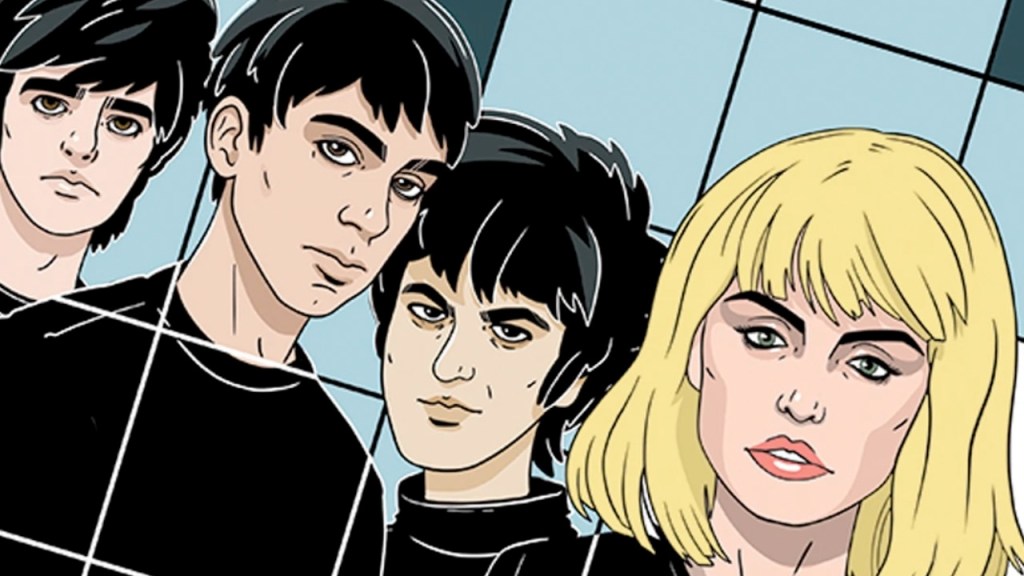Written by Jimmy Palmiotti, Amanda Connor,
Wendy Wright-Williams, Cassie Parkes,
David Avallone, Howard Rodman, Jazzlyn Stone,
Dan Whitehead, Davide Barnett, Richard Kadrey
Art by Various
Published by Z2 Comics
We’re awash in more and more biopics of musicians in the 21st century, and even more are on the way.
(Walk Hard: The Dewey Cox Story, a perfect parody that stabbed the heart of the music biopic trend, came out in 2007. Yikes!)
Hollywood is jumping ever more at musicians’ authorized (often extra-sanitized) histories, and for many reasons. We live in a time when the monoculture is largely gone amid algorithmically individualized media. Young people aren’t going to movie theaters. And icons of the recording industry’s heights of the late 20th century are dying off.
Hence Boomers and Gen Xers alike are seeing their folks onscreen a bunch.
Will Blondie ever get that same biopic treatment, and the New York punk scene along with it?
The 2013 film CBGB came and went, starring Alan Rickman as club owner Hill Kristal, the late Taylor Hawkins of Foo Fighters as Iggy Pop, and Malin Akerman as Debbie Harry. But other than that film and Sid and Nancy (1986), punk as biopic fodder remains elusive. I mean, some actor picking up an Oscar for playing you is as “selling out” as it gets, right? (Velvet Goldmine sidesteps this by making analogues to David Bowie and Iggy Pop.)
However, Z2 Comics is doing its part to continue immortalizing punk and other music icons with works such as Blondie: Against the Odds. This take on the band decides to go for something more fun as a graphic novel and artbook, pairing a biographical comic book with slipcover illustrations and various creators’ artistic interpretations of classic Blondie songs during their 1975-80 heyday.
This collection is like any good night of punk music in your local watering hole of yore: not every band may be great, but someone will be, and you’ll leave the party bleary-eyed with ringing ears and delirious memories if you let the feeling and fellowship wash over you.
Amanda Conner and Jimmy Palmiotti count off this jam session with an oral history split between Blondie’s guiding forces, Debbie Harry and Chris Stein. All the tropes of over-romanticized 1970s New York City are here, often with speaking roles: the rats, roaches and pigeons; the druggies and streetwalkers; the 42nd Street marquees and dilapidated tenement shooting galleries (heroin, not guns).
And the art by Montos goes both fantastical and grubby, like some mix of R. Crumb and Guillermo del Toro. (Whew, now a movie about the NYC punk scene from the vantage of a cockroach by GDT is something I’d pay money to see. Probably nobody else would, though.)
However, Conner, Palmiotti and Montos also go into details similar to Legs McNeil’s Please Kill Me about folding in Harry and Stein’s childhoods and the cultural artifacts of their 1950s childhoods and comings-of-age in the ’60s. Harry and Stein’s experiences with sci-fi, fantasy, blues records, patriarchal harassment, postwar abandonment, and more filtered their way into the creative enterprise that became Blondie. (A lot of punkers, in their own words, were ‘50s pop classicists looking to strip rock back to the roots.)
Montos’ art is coherent and disorienting at the same time, keeping the reader off-kilter just enough, to jar the reader to think and act and move – like the music did.
The section of the graphic novel titled “The Songs of Blondie” package slipcover art and comics interpreting each song. Among the best of them is the leadoff entry for “Fade Away & Radiate” from the Parallel Lines album, but you’d expect so when Colleen Doran draws the slipcover plate and J.H. Williams III knocks out images of a psychedelic spaceman floating away.
Some of the entries play with art style and form more, such as John Pearson’s take on “Hanging on the Telephone.” Or they pick on the more relentlessly danceable kick of “One Way Or Another” for Anthony Marques to tell a Western revenge tale. “Rapture” adds graffiti and Scott Pilgrim-ish looks thanks to Sharknife’s Corey “Rey” Lewis, though I would have preferred using a hip-hop artist on that one.
Blondie’s music also had a fanciful and pretty quality thanks to how Debbie Harry’s vocals could go as soft and ethereal as they could with snarl and bite. “Heart of Glass” by Cassie and Sebastian Piriz dives into a steampunk fantasy tale with a dying captain and a pirate raider with a ray gun. David Avallone and Lisa Weber’s on-the-nose interpretation of “Dreaming” turns Manhattan into Wonderland.
“Atomic” simply doesn’t work for me. This ode to sex and death allows for the listener to add whatever they want to it, and Howard A. Rodman and Manuela Pertega decide to tell the story of Julius and Ethel Roseberg, who were sentenced to death as Soviet spies. They rest their tale largely on the question of how involved Ethel was in Julius’ activities, and they depict Ethel’s love as life-and-death elemental.
The story is well made and well told, while at the same time it makes me want to look up a plethora of historical accounts and sources to determine how valid this interpretation may be. I simply wasn’t looking for that in a Blondie comic, and Rodman’s notes explaining his personal connection to the Rosenbergs’ story feels shoehorned in to justify why this story choice exists as not fitting in with the others.
But it is provocative and gave me good reason to get lost in the sex/death, disco-infused groove of “Atomic” from its “Three Blind Mice” interpolation to the four-on-the-floor synths and Harry’s voice floating like gorgeous doom.
Z2’s treatment of Blondie may not always hit, but it gives hope that these musicians seek films and other projects that fit their aesthetics beyond the Hollywood formula.
We could use more projects such as this and WEIRD: The Al Yankovic Story in the world, yes?



